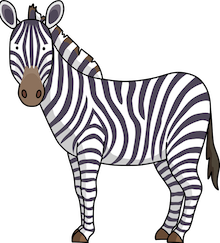It’s funny how the riddles and jokes we thought was so funny as a kid are still just as funny to our kids, and grandkids. Emily asked “what’s black and white and red all over?” on one of her recent visits. I guessed a newspaper, but the answer was a zebra with a sunburn. She thought that was pretty funny, so I thought I’d get a little deeper into the subject with her and I asked her whether zebras were white with black stripes or black with white stripes. Actually, all I got was a slightly puzzled look and the subject moved on to something more important….
But that question does have a (real) answer, and at the risk of spoiling any fun you might have speculating — zebras are black with white stripes.

All of a zebra’s fur, both black and white, grows from follicles that contain melanocyte cells. (Melanin is a dark pigment primarily responsible for skin color. Darker skin tones tones have more melanosomes present than lighter skin tones. Functionally, melanin serves as protection against UV radiation.) These cells are are present in all animals, and they’re primarily responsible for generating the pigment that gives color to skin and hair. Melanocyte cells produce melanin — the pigment — that is outwardly visible. In zebras, chemical messengers determine which melanocytes deliver pigment to which section of fur and creates the zebra’s black and white pattern. It’s interesting that the white fur on a zebra represents an absence of melanin….therefore, black is the “default” color of a zebra. If you shaved all the fur off a zebra, there would be no stripes — it would be an all-black animal.
So there you have it! Maybe a more interesting question is why do zebras have stripes at all? Turns out that that’s a much harder question — no one is really sure.
There seems to be dozens of theories as to why they have stripes… one theory that’s kind of interesting is that stripes provide protection from biting flies. A recent study found that striping on animals is more common in areas rife with biting flies — that may mean that biting flies struggle to see a striped or black-and-white surface as a safe place to land.
Another interesting theory is that of thermoregulation whose argument is based on the fact that black stripes absorb heat to warm zebras in the morning chill and white stripes reflect the sun to cool zebras in the afternoon heat.
So we do know what color a zebra is, but we don’t know why they have stripes. I read an article that suggested using zebras as a metaphor for racial harmony. Actually, that sounds like a good idea to me — after all, black or white, the footprints left in the dirt are the same….
— 30 —
